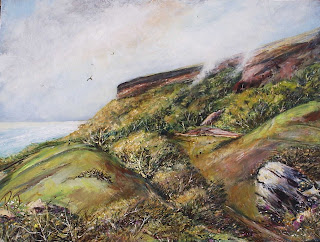
Well, not that honest... I've had a little spat on the Painters' Online website. Suggested that one of the paintings posted was very obviously of the Bob Ross school; the painter herself took no offence, and very reasonably pointed out that she might never have started painting at all if it weren't for the Bob Ross workshops locally. But another contributor, I think it's fair to say, did take offence; not least because I had (I thought rather gently) suggested that a previous painting of hers might be improved.
Tricky business, this art criticism lark. The wise man eschews it. A word, though, about Bob Ross. He was a US ex-serviceman who took up painting, had a tv programme, and pursued what he called wet-in-wet oil painting, which involved laying a coat of very liquid titanium white on a canvas, and painting into it with colour. As a method, there's nothing very special about it, other than that if you aren't careful how much oil you mix with the initial coat you run the risk of the paint film cracking later on. Or yellowing. Or both. It isn't so much the method of applying the paint that's the problem, as the utterly predictable results the Bob Ross approach produces. He very rarely painted from life; most of his pictures were entirely from his own imagination, and his imagination seemed to live entirely in Alaska, where he had been based when in the forces.
And so he became a virtual production line of basically the same half dozen paintings; which wouldn't matter so much except that all the Bob Ross "instructors" throughout the world (it's turned into a big business) just replicate these not very good paintings; and their students produce versions of those same paintings; and so you seem them everywhere, lovingly crafted no doubt, but of a landscape which they've never seen... So you get the sea with waves formed in exactly the same configuration as the master employed; trees that are ... well... Bob Ross trees, rather than any species you could identify.
I don't complain if a painting isn't very good; some of mine aren't brilliant (feel free to contradict here); but I don't see any point at all in just copying a copy of a copy of a work that wasn't all that great to start with.
If you see a painting - and you must have - of a range of mountains with a lake in front of them, a yellowish/pinkish sky, trees of a sort of indeterminate breed, and grass painted as though it were minced leaves of cabbage, you have a product of the Bob Ross school. The method goes round in circles and gets nowhere; and what annoys me about it is a) that the students learn nothing worth knowing, and have to make a real effort to break with the method if they're ever to produce anything original of their own, and b) that the instructors within the great Bob Ross empire get to put CRI (certified Ross Instructor) after their names, as if it were an academic qualification.
Now, Bob Ross was not a bad man; from all I've read of him, he was a very good man, and died tragically early. He was an engaging broadcaster, in the sense that he had an extremely relaxing voice and friendly, approachable manner. But - he has been, in my not so humble opinion, an appalling influence; his tutors perpetuate this influence; and I wish there were other places for people to go to learn how to paint well. Under present economic conditions, night schools, tech college courses etc are thin on the ground. And you can't blame - even I can't blame - the Bob Ross empire from filling in the gap. But those wanting to learn to paint would do far better to buy a good book, or subscribe to one of the several art magazines, than sign up to good ole' Bob and his "happy little tree" approach to painting.
Still; each to their own, I suppose...
Welcome, new followers: together, we shall conquer the World!!









.JPG)








